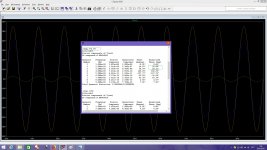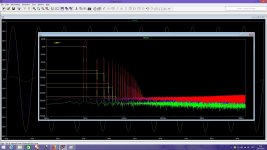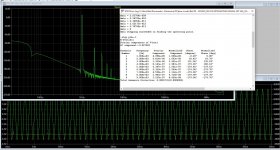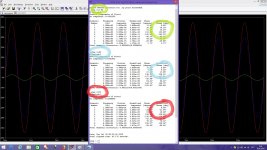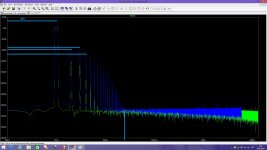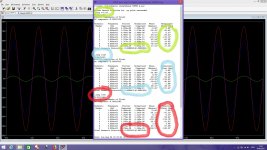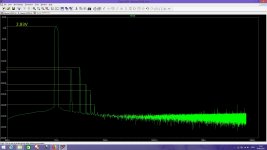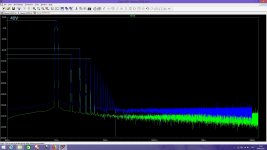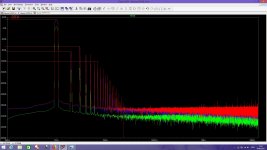Hello. Look interested in the phase of the harmonics. Voltage and phase in degrees circled in color. Do not always get low values, does this make any sense?
Attachments
Last edited:
The amplitudes are very low, and the phase shifts are rather unusual.
You have H3 higher than H2, and H5 higher than H4. I try to have a monotonic decrease with H2 dominant but it's not easy to achieve at very low values you show here.
I normally see high negative degree phase shift on H3 and beyond harmonics, like this:
Harmonic Frequency Fourier Normalized Phase Normalized
Number [Hz] Component Component [degree] Phase [deg]
1 2.000e+04 1.406e+01 1.000e+00 175.07° 0.00°
2 4.000e+04 4.021e-03 2.861e-04 -53.10° -228.17°
3 6.000e+04 1.370e-04 9.751e-06 -173.70° -348.77°
4 8.000e+04 1.072e-03 7.624e-05 -29.62° -204.69°
5 1.000e+05 4.182e-04 2.975e-05 -117.38° -292.45°
6 1.200e+05 6.156e-04 4.380e-05 -20.20° -195.27°
7 1.400e+05 5.645e-04 4.017e-05 -109.75° -284.82°
HD
You have H3 higher than H2, and H5 higher than H4. I try to have a monotonic decrease with H2 dominant but it's not easy to achieve at very low values you show here.
I normally see high negative degree phase shift on H3 and beyond harmonics, like this:
Harmonic Frequency Fourier Normalized Phase Normalized
Number [Hz] Component Component [degree] Phase [deg]
1 2.000e+04 1.406e+01 1.000e+00 175.07° 0.00°
2 4.000e+04 4.021e-03 2.861e-04 -53.10° -228.17°
3 6.000e+04 1.370e-04 9.751e-06 -173.70° -348.77°
4 8.000e+04 1.072e-03 7.624e-05 -29.62° -204.69°
5 1.000e+05 4.182e-04 2.975e-05 -117.38° -292.45°
6 1.200e+05 6.156e-04 4.380e-05 -20.20° -195.27°
7 1.400e+05 5.645e-04 4.017e-05 -109.75° -284.82°
HD
I specifically singled out yellow, the level of 2.83V, and in the same place indicated the phase in degrees for the same 2.83V. Where did you see H3 above H2 and H5 above H4? All harmonics highlighted in yellow fall one after the other.
Not only the harmonic level is small, but the phase shift too. Yes, it looks unusual, because the level of harmonics is extremely small.
The blue level is 40V RMS (for a load of 8 ohms it is 100 watts). The red level is 55V RMS (for a 8Ohm load, this is 189 W). Are you trying to achieve a monotonous reduction in harmonics for a 55V sine wave in your amplifier? Are you listening to a sine wave through your speakers at maximum power?
Specify at what voltage you showed these your phase shifts.
Not only the harmonic level is small, but the phase shift too. Yes, it looks unusual, because the level of harmonics is extremely small.
The blue level is 40V RMS (for a load of 8 ohms it is 100 watts). The red level is 55V RMS (for a 8Ohm load, this is 189 W). Are you trying to achieve a monotonous reduction in harmonics for a 55V sine wave in your amplifier? Are you listening to a sine wave through your speakers at maximum power?
Specify at what voltage you showed these your phase shifts.
Last edited:
I believe there are folks in the Pass Labs subforum who can provide some insight about the phase angle of distortion products. NP has done some study of this in terms of the subjective sound, etc.
Changing the phase of harmonics changes the waveshape drastically.
But it doesn't change the sound much, if at all, except in extreme cases.
But it doesn't change the sound much, if at all, except in extreme cases.
In some cases, especially in my, where the amplifier is without general feedback, this is a convenient way to fine tune. The last example is not yet the ideal setting, but it is very clearly printed out. To assess the impact on the sound, first-class Cabasse speakers are needed, which perfectly convey spatial 3D characteristics and, at the same time, are very musical.Hi Gunfu,
I made myself the same question many times, however never asked on the forum.
I have something similar: H2 = 18,7°
Have no idea how important the phase angles of the harmonics are.
Attachments
I feel its much more useful to look at the distortion residual rather than try to devine information indirectly from the phase angles.
It often happens that the distortions of two amplifiers are about the same, while the phase shifts are very different.I feel its much more useful to look at the distortion residual rather than try to devine information indirectly from the phase angles.
Hi guys. I decided to reconfigure the amplifier, for all tested amplitudes 2.83V, 40V, 55V and again at a load of 8 ohms.
This time I limited the phase rotation angle for all harmonics to 180 degrees. The result exceeded all expectations. Note the extremely short range of distortion.
It is also seen that the phase shift of the third harmonic at all three amplitudes is very small.
It is possible that the phase shift at the third harmonic is the most significant in the process of tuning your amplifiers, too.
This time I limited the phase rotation angle for all harmonics to 180 degrees. The result exceeded all expectations. Note the extremely short range of distortion.
It is also seen that the phase shift of the third harmonic at all three amplitudes is very small.
It is possible that the phase shift at the third harmonic is the most significant in the process of tuning your amplifiers, too.
Attachments
Last edited:
Firstly, it is a circuit model without general feedback.
So you are achieving better than -120dB distortion (1kHz) at high power
without global feedback? How does it measure at 20kHz, same power?
TCD
These are good questions. Unfortunately, with such a high resolution of the generator, even at 1 kHz, the program begins to count for a very long time.
Probably, the measurement procedure on real instruments with limited accuracy will be changed to measure distortion at high frequencies.
Probably, the measurement procedure on real instruments with limited accuracy will be changed to measure distortion at high frequencies.
I've done a fair amount of spice simulation work with a Pass F7 iteration regarding harmonics.Mr.Pass mentions some people prefer higher 2nd harmonic than 3rd harmonic and some prefer higher 3rd than 2nd.In addition 2nd harmonic can be either positive or negative phase as referred to the fundamental.A perfect negative phase 2nd harmonic reads as +90 degrees on the 2nd harmonic line in the spice error log.Conversley perfect positive phase 2nd harmonic reads as -90 degrees.Audibly I have found neg. phase 2nd gives a wider soundstage and mellower tone,positive 2nd is more focused and in your face.Higher 2nd harmonic is a mellower sound whereas higher 3rd harmonic is a more direct in your face sound.These are my observations and others have commented similar findings.
If this is true, then these are very interesting observations. It is possible that the output stage circuitry, symmetrical or not, can also influence these observation results. I still do not understand how these harmonics can be controlled and can be finely tuned. I think this is aerobatics. Can you give a link to these observations in his Mr.Pass subject?
My observations are that a power amplifier with significantly high H2 compared to H3 and with a monotonic descending harmonic character, does not generally handle complex music very well.
Whereas, an amp with either equal H2, H3 or slightly higher H3 does handle complex music much better. Instruments are more defined. If H2 is added at the small signal amplification stage, like preamp or buffer, the latter amplifier set up is very pleasing in all aspects.
Others' impressions of wider and deeper sound stage with negative phase H2 applies always, but dependent on speaker resolution.
Whereas, an amp with either equal H2, H3 or slightly higher H3 does handle complex music much better. Instruments are more defined. If H2 is added at the small signal amplification stage, like preamp or buffer, the latter amplifier set up is very pleasing in all aspects.
Others' impressions of wider and deeper sound stage with negative phase H2 applies always, but dependent on speaker resolution.
Thus, it is possible that even the second harmonic phase can be tuned in any industrial two-component amplifier. In which the preamplifier and power amplifier are separate. For example, change the phase of the XLR audio cable. At the same time, the phase of the connected speakers also changes to the opposite. So the overall phase remains the same.My observations are that a power amplifier with significantly high H2 compared to H3 and with a monotonic descending harmonic character, does not generally handle complex music very well.
Whereas, an amp with either equal H2, H3 or slightly higher H3 does handle complex music much better. Instruments are more defined. If H2 is added at the small signal amplification stage, like preamp or buffer, the latter amplifier set up is very pleasing in all aspects.
Others' impressions of wider and deeper sound stage with negative phase H2 applies always, but dependent on speaker resolution.
Thus, it is possible that even the second harmonic phase can be tuned in any industrial two-component amplifier. In which the preamplifier and power amplifier are separate. For example, change the phase of the XLR audio cable. At the same time, the phase of the connected speakers also changes to the opposite. So the overall phase remains the same.
Many of us, including the great Nelson Pass have lost sleep over this. In fact, it all began with him.
If your preamp produces positive phase H2 and keeps absolute phase of your signal intact, there's nothing much you can do. You either listen to positive phase, more in your face, two rows in front, type of sound. Or invert the speaker cable, listen to negative phase, pleasing H2, but also suffer loss/inversion of absolute phase.
If the preamp produces positive phase H2 but inverts the phase of the signal, flip the phase either from preamp to power amp (if balanced signal) or flip speaker cables. You listen to pleasing H2 and maintain signal phase integrity.
Or your preamp produces negative phase H2 while maintaining absolute signal phase, you wire straight, no flipping.
So you can deliberately add H2 anywhere, but only once in the chain and flip polarity only once, if called for. Flipping twice will defeat the purpose.
Apply the same logic to only power amp producing H2.
- Home
- Amplifiers
- Solid State
- Phase of the harmonics
